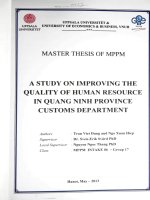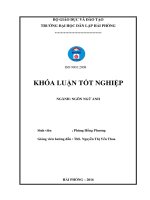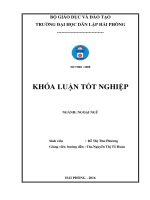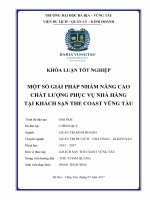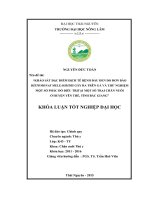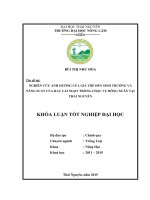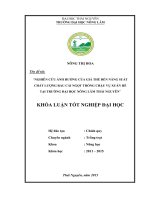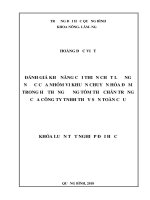Revealed the origin of the mong cai pig population in quang ninh province by studying the specific gene sequences (khóa luận tốt nghiệp)
Bạn đang xem bản rút gọn của tài liệu. Xem và tải ngay bản đầy đủ của tài liệu tại đây (2.59 MB, 73 trang )
VIETNAM NATIONAL UNIVERSITY OF AGRICULTURE
FACULTY OF BIOTECHNOLOGY
THESIS
TITLE:
REVEALED THE ORIGIN OF THE MONG CAI PIG
POPULATION IN QUANG NINH PROVINCE BY
STUDYING THE SPECIFIC GENE SEQUENCES
HANOI – 2022
VIETNAM NATIONAL UNIVERSITY OF AGRICULTURE
FACULTY OF BIOTECHNOLOGY
THESIS
TITLE:
REVEALED THE ORIGIN OF THE MONG CAI PIG
POPULATION IN QUANG NINH PROVINCE BY
STUDYING THE SPECIFIC GENE SEQUENCES
Student
: Cao Thi Thu Thuy
Course
: 63
Department
: Biotechnology
Supervisor
: MSc. Nguyen Quoc Trung
HANOI – 2022
COMMITMENTS
I hereby declare that all the data and results in this thesis are frank and
have never been used in any reports yet.
I also assure the information cited in my thesis indicated its origin, and all
the help is appreciated.
Hanoi, December 2022
Student
Cao Thi Thu Thuy
i
ACKNOWLEDGEMENTS
First and foremost, I have to express my appreciation to the directory of
the Vietnam National University of Agriculture, the board of deans, and lectures
in the Faculty of Biotechnology for creating a meaningful learning environment
and providing me the precious knowledge throughout my academic years.
In terms of the thesis conducting process, many people helped me a lot to
complete this study. Specifically, this is my dear supervisor, MSc. Nguyen Quoc
Trung, who brings the most inspiration and aspiration for me to pursue
bioscience. Without his support throughout these two years, I would not have
gained as many honors as I have at present.
Besides, I cannot neglect the ardent support from my lab-mates in the
Laboratory of Molecular Biology and Applied Biotechnology, there is no word
to express my gratitude to the whole of you. In addition, I would like to
sincerely thank the lecturers and students from the Faculty of Veterinary
medicine, VNUA for their help during the sample-collecting trip. This study
also gained financial support from the People’s Committee in Quang Ninh
province, Vietnam (Conservation of Mong Cai pig genetic resources in Quang
Ninh province, 2021-2023).
Last but not least, I would like to thank my nearest and dearest, thank
Timmy, who was there for me through all my ups and downs, until this point
and my academic career way later.
Hanoi, December 2022
Student
Cao Thi Thu Thuy
ii
TABLE OF CONTENTS
COMMITMENTS ........................................................................................................... i
ACKNOWLEDGEMENTS ........................................................................................... ii
TABLE OF CONTENTS .............................................................................................. iii
LIST OF ABBREVIATIONS .........................................................................................v
LISTS OF TABLES ...................................................................................................... vi
LIST OF FIGURES ....................................................................................................... vi
ABSTRACT ................................................................................................................ viii
Chapter I. INTRODUCTION ..........................................................................................1
Chapter II. LITERATURE REVIEW..............................................................................4
2.1.
Evolution and domestication of pigs ..................................................................4
2.2.
Molecular study of evolution and domestication of pigs ...................................6
2.2.1.
Studies based on mitochondrial genome ............................................................7
2.2.2.
Studies based on nucleus DNA ........................................................................10
2.2.3.
Studies based on MC1R sequence ....................................................................13
2.3.
Study on origin and phylogeny of Mong Cai pig breed based on DNA
analysis .............................................................................................................21
2.3.1.
Study on nucleus DNA in Mong Cai pig .........................................................21
2.3.2.
Study on Mong Cai pig phenotype ...................................................................24
2.3.3.
Study on Mong Cai pig mitochondrial genome ...............................................25
Chapter III. MATERIALS AND METHODS ..............................................................28
3.1.
Materials ...........................................................................................................28
3.2.
Methods ............................................................................................................28
3.2.1.
Sampling and DNA extraction method ............................................................28
3.2.2.
Study on mtDNA methods ...............................................................................29
3.2.3. Study on MC1R sequence .................................................................................31
Chapter IV. RESULTS AND DISCUSSION ................................................................34
4.1. Mitochondrial DNA sequence analysis ..................................................................34
iii
4.1.1. Phylogeny study on mtDNA D-loop sequence of Mong Cai pig and other 15
pig breeds..........................................................................................................34
4.1.2. Developing marker set to determine the maternal origin of Mong Cai pig ........37
4.2. MC1R gene sequence analysis results ....................................................................39
4.2.1. Sequencing and polymorphism detection............................................................39
4.2.2. Haplotype diversity .............................................................................................41
4.2.3. Phylogenic analysis .............................................................................................42
4.2.4. Accession numbers ..............................................................................................44
4.3. Discussion ...............................................................................................................44
4.3.1. Diversity in the Mong Cai pig population ...........................................................44
4.3.2. The potential association between MC1R gene and coat color of Mong Cai
pig .....................................................................................................................45
4.3.3. Origin of Mong Cai breed ...................................................................................47
Chapter V. CONCLUSIONS AND PROPOSALS .......................................................49
5.1. Conclusions ............................................................................................................49
5.2. Proposals .................................................................................................................50
REFERENCES ..............................................................................................................51
APPENDIX ...................................................................................................................55
iv
LIST OF ABBREVIATIONS
Abbreviation
Meaning
α-MSH
α-melanocyte-stimulating Hormone
ASP/ ASIP
Agouti-signaling Protein
BC
Before Christ
cAMP
Cyclic Adenosine Monophosphate
D-loop
Displacement loop
ESR1
Estrogen Receptor 1
EDNRB
Endothelin Receptor Type B
GPIP
Glucose Phosphate Isomerase-processed
MC1R
Melanocortin Receptor 1
MITF
Melanocyte Inducing Transcription Factor
MSA
Multiple Sequence Alignment
mtDNA
Mitochondrial DNA
PCR
Polymerase Chain Reaction
SNP
Single Nucleotide Polymorphism
TYR
Tyrosinase
TYRP1
Tyrosinase-Related Protein 1
UPGMA
Unweighted Pair Group Method using arithmetic Averages
VnP
Vietnamese native Pig
v
LISTS OF TABLES
Table 3.1: Genbank accession codes for mtDNA pig breeds and the site of
D-Loop region
29
Table 3.2: PCR primers and conditions used for amplification of
melanocortin 1 receptor (MC1R) gene
32
Table 4.1: The detected variation in the D-Loop region among Mong Cai
pigs and 15 other pig breeds in Asia and Europe
34
Table 4.2: PCR primers and conditions used for amplification of fragment in
mtDNA D-loop region.
37
Table 4.3: Expected bands amplified by two primer pairs designed based on
mtDNA sequences
38
Table 4.4: Variations of the melanocortin 1 receptor (MC1R) gene and
allelic frequency in the European pigs, Asian pigs, and Mong Cai
pigs based on coat color phenotype.
40
Table 4.5: Haplotypes and polymorphism in the melanocortin 1 receptor
(MC1R) gene among Mong Cai pigs, European pigs, and Asian
pigs.
41
Table 4.6: Haplotypes distribution in data set of Mong Cai pigs, European pigs,
and Asian pigs.
41
vi
LIST OF FIGURES
Figure 2.1: The domestication of the Eurasian or “Russian” boar resulted in
hundreds of breeds of domestic pigs............................................................... 5
Figure 2.2: Schematic overview of the history of the pig (Sus scrofa). ........................ 6
Figure 2.3: Mitochondrial genome position (source: ....... 7
Figure 2.4: Pedigree depicting mitochondrial inheritance that shows inheritance
is transmitted through the maternal line. ........................................................ 8
Figure 2.5: Neighbor-joining trees of wild boar and domestic pig mitochondrial
DNA haplotypes (Giuffra et al., 2000).........................................................11
Figure 2.6: Tong Cheng pig .............................................................................................13
Figure 2.7: Allele frequency of c.699 in ESR1 in Chinese pigs and European pigs
(C. Wang et al., 2015) ....................................................................................13
Figure 2.8: Melanin synthesis-biochemical pathway (Robins, 1991; Searle,
1968) ................................................................................................................15
Figure 2.9: The model of the genetics of coat color determination in mice................17
Figure 2.10: Phenotype and geographical origin of the 20 European pig breeds:......19
Figure 2. 11: Distribution of some typical Chinese local pig breeds. (Y. Wang et
al., 2022)..........................................................................................................20
Figure 2.12: The unweighted pair-group method using arithmetic averages
dendrograms based on Nei’s (1972) model (Nguyen Thi Dieu Thuy et
al., 2006)..........................................................................................................22
Figure 2.13: Geographical localizations of eight pig populations analyzed in this
study. (Pham Doan Lan et al., 2014) ............................................................23
Figure 2.14: Genetic relationship among eight studied pig populations. (Pham
Doan Lan et al., 2014)....................................................................................24
Figure 2.15: Multiple correspondence analysis of the characteristics of
Vietnamese native pig populations shows the distributions of the
various Vietnamese native pig breeds. (Ishihara et al., 2020)....................25
vii
Figure 2.16: The UPGMA phylogenetic tree of 162 pig complete mitochondrial
DNA sequences. (Thuy Nhien Thi Tran et al., 2016).................................26
Figure 4.1: ML phylogenic tree based on the mtDNA D-loop in the dataset (2
Mong Cai pigs, 15 other pig breeds).............................................................36
Figure 4.2: PCR product of the partial mtDNA D-loop region amplified by
Mtmc3 primer .................................................................................................39
Figure 4.3: PCR product of the partial mtDNA D-loop region amplified by
Mtmc4 primer .................................................................................................40
Figure 4.4: The phenotypes of knotted black saddle (left) and seamless black
saddle (right) Mong Cai pigs. ........................................................................42
Figure 4.5: ML phylogenic tree based on the coding sequence of MC1R gene in
the dataset (26 Mong Cai pigs, 20 Asian and European pigs). ..................43
viii
ABSTRACT
This study focuses on revealing the origin of Mong Cai pig population at
present through research on the mitochondrial genome (mtDNA) D-loop
sequence and melanocortin 1 receptor (MC1R). A total of 96 individuals were
sampled at four swine farms in Quang Ninh province. The mtDNA D-loop of
the Mong Cai pig was aligned with other breeds to design DNA primers that
could identify the maternal origin of this breed. Two primer pairs Mtmc3 and
Mtmc4 were developed and amplification results showed a total of four band
sizes representing four pig breeds for each primer pair. The coding sequences of
MC1R gene of 26 selected Mong Cai individuals were sequenced and aligned
with 20 other pig breeds from Europe and Asia. Twelve haplotypes were
determined using 18 mutations in 46 individuals. Mong Cai population was
distributed into four haplotypes. The phylogenetic tree revealed that Mong Cai
pigs belonged to the Asian clade while six Mong Cai individuals formed a
distinct cluster. These six individuals carry the nt729G gene, which is prevalent
in European pigs. This study provided strong evidence for the Asian origin of
Mong Cai pig and showed the diversity in maternal lineage in Mong Cai
population at present. The crossbreeding trend resulted in variation in the typical
black saddle coat color phenotype of Mong Cai pigs, and this is linked to the
SNP c.729A>G.
ix
Chapter I. INTRODUCTION
The Mong Cai pig (Sus scrofa) is one of Vietnam’s unique indigenous pig
breeds. It originated in the Mong Cai district of Quang Ninh province, adjacent
to the Chinese border, where it was first documented. This pig breed is an
important factor in the domestic economic growth in Northern Vietnam due to
its better reproductive ability than international pig breeds while requiring
inexpensive plant food sources. With their high fertility characteristic, Mong Cai
sows have been bred with western boars as Yorkshire, Landrace, Pietrain, etc.
for F1 crossbred products and meat production since the turn of the 20 th century
(Lemke et al., 2008). The body shape of the Mong Cai pigs is typical of the
local pig breed: short body, short neck, small ears, small and short legs,
swayback backline, and a drooping shaped belly (Ishihara et al., 2020).
Especially, the black saddle coat that extends from the hips to the lower
abdomen on Mong Cai pigs is distinctive (Duc Nguyen Van, 2006). With the
state of the introduction of exotic breeds as well as crossbreeding at present,
many variations in phenotypes of Mong Cai pigs have occurred, obviously the
black saddle color phenotype. Therefore, the origin of the Mong Cai population
now is important to investigate.
First of all, the study of genetic diversity based on mitochondrial DNA
(mtDNA) as a maternal line has been a reportedly useful tool as a molecular
marker. MtDNA is maternally inherited and experiences nucleotide changes
faster than DNA (Brown et al., 1979), which makes mtDNA an ideal tool for
studying population genetics (Bailey et al., 2000).
In addition, the diversity in black saddle coat color in Mong Cai pigs at the
moment is obviously to be seen, which makes it less typical than that in the past.
Besides, as a result of human domestic selection, the color of pigs’ coats varies
by region. Several important genes affecting pig coat color phenotypes have
been identified to date, including KIT (Fang et al., 2009; Johansson Moller et
1
al., 1996; Kijas et al., 1998; Marklund et al., 1998), MITF (Chen et al., 2016),
ASIP (Drögemüller et al., 2006), TYRP1 (Ren et al., 2010), and EDNRB (Ai et
al., 2013). Melanocortin 1 receptor (MC1R) determines dominant black, blackspotted, and red coat colors in both western and Chinese pigs (Fang et al., 2009;
Kijas et al., 1998). This is a G protein-coupled receptor that is predominantly
expressed in melanocytes and plays a key role in melanogenesis by regulating
the production of red/yellow pheomelanin and dark eumelanin. MC1R variants
associated with the domestication of Asian and European pig breeds have been
identified through characterization (Andersson, 2003).
Most genetic studies on the evolution and domestication of pigs were
carried out based on both mtDNA and nuclear genes to provide a comprehensive
view. Thus, this study was carried out to examine the origin of the Mong Cai pig
population in Quang Ninh province based on two specific nucleotide sequences,
providing additional information on the genetic resource strategy of this
indigenous pig breed in Vietnam.
Objectives:
- Clarification of the origin of the Mong Cai pig population in Quang Ninh
province based on the mitochondrial genome and MC1R gene
Requirements:
Study on the maternal lineage of Mong Cai pigs:
• Aligning and comparing the mtDNA D-loop region between Mong Cai
pigs and other pig breeds that were raised on the same swine farms in Quang
Ninh province;
• Designing a marker set based on mtDNA D-loop sequence to
discriminate Mong Cai pig from other pig breeds;
• Surveying the designed marker set by PCR and gel electrophoresis
reactions.
Study on MC1R gene and the black saddle coat color of Mong Cai pigs:
• Amplifying and sequencing the MC1R gene in 26 Mong Cai pigs;
2
• Investigate the haplotype diversity in MC1R sequence among Mong Cai
individuals;
• Construct the phylogenetic tree to illustrate the relationship between the
Mong Cai pig and other pig breeds in the world.
3
Chapter II. LITERATURE REVIEW
2.1. Evolution and domestication of pigs
The pig (Sus domesticus), also called swine, hog, or domestic pig when
distinguishing from other members of the genus Sus, is an omnivorous,
domesticated, even-toed, hoofed mammal. It is variously considered a
subspecies of Sus scrofa (the wild boar or Eurasian boar) or as a distinct species.
In 1859, Charles Darwin published “On the Origin of Species”, a work
that would become the cornerstone of evolutionary biology. This book outlined
the scientific theory of natural selection and species diversity through evolution
over successive generations. In his book “The Variation of Animals and Plants
under Domestication” later published, Darwin recognized two main forms of
domestic pigs: the European (Sus scrofa) and the Asian (Sus indicus) form,
whose wild ancestor was unknown. He considered these two forms to be distinct
species due to fundamental phenotypic differences. It is believed that Asian pigs
were used to improve pig breeds during the 18th and early 19th centuries
(Darwin, 1868; Jones, 1998) but to what extent Asian pigs have contributed
genetically to different European pig breeds remained unknown.
In the last 10,000 years, as humans spread across the globe, pigs
accompanied them and played a crucial role in the development of society. An
extensive zooarchaeological record has shown that domestic pigs descended
from the Eurasian wild boar, and these were first identified around 8500 BC in
Near East. The domestication process primarily means a safer and more efficient
alternative to hunting wild boar with a spear, which begins the radical
conversion of the Eurasian boar into the domestic pig (Sus scrofa domesticus) on
the farm. The latest phylogeographic evidence suggests that domestication of
this species occurred multiple times and at different locations in Asia, Southeast
Asia, India and Africa, especially Europe.
4
Figure 2.1: The domestication of the Eurasian or “Russian” boar resulted in hundreds
of breeds of domestic pigs.
(Source: Texas A&M, Natural Resources Institute)
Wild boars in today’s landscape are well equipped to represent an
enormous scale of damage to agriculture, water quality, native species, and
habitat. Through strong artificial selection, humans have chosen individuals with
preferred traits, such as high animal yield, extreme fertility, intelligence, and
others to produce an efficient and productive animal farm. The domestication
process gradually shifted to mutating a heavy Eurasian boar turned into a local
lop-eared pig. This change did progress obviously, and there are several breeds
of domestic pigs of all sizes and colors at this time. Domestication provides an
ideal model for testing many evolutionary questions, including the relationship
between molecular and morphological changes and whether these changes
associated with domestication resulted primarily from a release of natural
selection pressures, selection for genetic variation in the wild ancestor, or
positively resulted in selection for new mutations that arose after domestication.
5
Figure 2.2: Schematic overview of the history of the pig (Sus scrofa).
Four main events are indicated: 1) Speciation of Sus in ISEA. 2) Divergence between
European and Asian S. scrofa.3) Independent domestication leading to separate domesticated
clades in Europe and Asia.4) Hybridization between domesticated pigs from Asia and Europe.
(Bosse, 2020)
2.2. Molecular study of evolution and domestication of pigs
There was a confusing conclusion about the domestication timescale
between archaeology and molecular study. The DNA research said that modern
European pigs are derived from European wild boar and not Near Eastern
animals. Researchers have often wondered whether that means pigs were also
independently domesticated in Europe. Historically it has been problematic to
classify archaeological pig remains as wild, hybrid, or domestic just by
examining the shape of their skeletons.
6
2.2.1. Studies based on mitochondrial genome
2.2.1.1. Overview of the function of mitochondrial genome and D-loop region
in inheritance
Figure 2.3: Mitochondrial genome position (source: />
Mitochondrial DNA is the circular chromosome found inside the
organelles of the cell called mitochondria and located in the cytoplasm.
Mitochondria are known as the organelles that produce ATP, which is the main
source of energy for cells and other metabolic functions. Mitochondrial genome
consists of 0.1% of the total human genome and is inherited exclusively from
mother to offspring.
Genetic changes in mtDNA can occur in single genes or as larger
rearrangements of DNA in a circle. These alterations can occur at any point in
life and usually result in cells that have a mix of normal and altered mtDNA,
known as heteroplasmy. Some of the mtDNA alterations could be passed
through the egg to the offspring, but not from the sperm. It is an inherited
pattern that honestly involves both males and females, but always with the
condition passed on through the female line (maternal inheritance). Because
many mitochondria are passed from ovarian cells to the oocyte, all children of
7
an affected woman are at risk of inheriting the disease, depending on the
proportion of mutant mitochondria they inherit. An affected male does not pass
on his mitochondria to his children, so his children will not be affected (Figure
2.4).
Figure 2.4: Pedigree depicting mitochondrial inheritance that shows inheritance is
transmitted through the maternal line.
(Source: NHS National Genetics and Genomics Education Centre)
Furthermore, mtDNA is known for having high acquired mutation rates
which are 10 times higher than that of nuclear genomic DNA (Brown et al.,
1979). Because of the high rate of evolution, mtDNA is a useful tool for
studying population genetics and evolutional process. This is useful for to
discover the genetic relationship within and between populations that have a
close relationship and population bottlenecks (Luetkemeier et al., 2010).
In addition, there is a closed circular area with a complete nucleotide
sequence and a non-coding region named displacement loop (D-loop) that lasts
more than 1000 bp in pigs. The D-loop region acts as a promoter for both the
heavy and light strands of the mtDNA and contains essential transcription and
replication factors. Recent studies proved that the mtDNA D-loop region could
be used in research of determining maternal and genetic linkage (Purwantini et
al., 2013; Tsai et al., 2009.
8
2.2.1.2. Study of evolution and domestication of pigs based on mitochondrial
genome
Studies of ancient mitochondrial DNA
further show that 4500 BC
domesticated pigs with Middle Eastern haplotypes appeared in Northern Europe
(Krause-Kyora et al., 2013). DNA analysis shows that most Near Eastern
ancestors of European domestic pigs disappeared around 3000 years ago due to
gradual interbreeding with European wild boar (Frantz et al., 2019). There were
many farmers reported that wild boars often break into a herd of domestic pigs
and mate with females, transferring their genes to the herd. Most importantly,
research suggested that pigs were not independently domesticated in Europe.
Rather, the herds that were allowed to roam the land interbred with wild boar.
This could have happened accidentally and haphazardly, or it could have been a
conscious decision by farmers who wanted to improve their animals on farms.
There were plenty of studies on mtDNA conducted to research
domestication and divergence between European and Asian pigs. The earliest
studies by Okumura et al., 1996; Watanabe et al., 1986 indicated the difference
in terms of genetics between these two types of pig but have not provided the
divergent timescale.
In 1999, Giuffa et al. made a breakthrough in pig genetics that has
important implications for the conservation and utilization of genetic diversity in
this livestock species. The research provided a more complete molecular
analysis of domestic pig ancestry through analysis of wild and domestic pigs
from Asia and Europe (Giuffra et al., 2000). The molecular analysis included
the complete coding sequence of the mtDNA cytochrome B (cytB) gene and 440
bp of the mtDNA hypervariable control region. The authors sequenced
mitochondrial DNA and nuclear genes from wild and domestic pigs from Asia
and Europe. Clear evidence has been found that domestication occurs in Europe
and Asia, regardless of wild boar subspecies. In detail, the phylogenetic analysis
of the hypervariable D-loop region revealed three distinct mtDNA clades, one
Asian and two European (Figure 2.5A, 2.5B). All mtDNA haplotypes of
9
suspected European origin found in domestic pigs belonged to the European
clade 1 (consisting of most European wild boar, Israeli wild boar, most
European domestic pigs, and the Cook Island pig). Phylogenetic analysis of the
cytB sequences again showed a statistically supported Asian clade, but the
presence of two distinct European clades was not statistically significant. The
time elapsed since the divergence of ancestral forms has been estimated at
500,000 years, well before domestication 9,000 years ago. Historical records
indicate that Asian pigs were introduced to Europe in the 18 th and early 19th
centuries. They found molecular evidence for this introgression, and the data
pointed to a hybrid origin of some of the major “European” pig breeds.
Another 2013 study combining both genetic (ancient mtDNA and nuclear
genome) and morphometric (molar size and shape) approaches and applied to
the 63 pigs showed that hunters-gatherers in Northern Germany acquired
domestic pigs of different sizes and coat colors that had both Middle Eastern and
European mtDNA ancestry (Krause-Kyora et al., 2013). Their results showed
that Mesolithic Ertebølle hunter-gatherers in Northern Europe not only owned
domestic pigs like those of their agricultural neighbors, but that these animals
were present in the region some 500 years earlier than previously shown.
2.2.2. Studies based on nucleus DNA
In 1999, a study analyzed three nuclear genes: melanocortin receptor 1
(MC1R), tyrosinase (TYR), and a glucose phosphate isomerase pseudogene
(GPIP) in pigs to investigate the divergence between European and Asian pigs
(Giuffra et al., 2000). This study released the difference between the alleles of
these two pigs. About the GPIP gene, since both MC1R and TYR are coding
sequences, the GPIP pseudogene was involved in to study as a noncoding
nuclear sequence. There was also a clear tendency for more pronounced allele
frequency differences between continents than between wild and domestic pigs
within continents. Their work supported the independent domestication of pigs
in Europe and Asia.
10
Figure 2.5: Neighbor-joining trees of wild boar and domestic pig
mitochondrial DNA haplotypes (Giuffra et al., 2000).
Which were based on (A) 440 bp of the control region and (B) 1140 bp of the cytB
gene. Abbreviations and geographical location for the wild boar samples are as follows:
EWB, European wild boar; IWB, Israeli wild boar; AWB, Asian wild boar; EWB1-2, Poland;
EWB3-5, Italy; AWB6-9, Ryukyu Island, Southern Japan; AWB10-14, Japan. Abbreviations
for domestic pig breeds are as follows: L, Swedish Landrace; H, Hampshire; Ma, Mangalica;
LW, Large White; Me, Meishan; D, Duroc; Cook, Cook Island.
In 2015, C. Wang et al. studied the genetic basis underlying the
morphological and behavioral adaptations of Chinese indigenous pigs. The
authors did a genome-wide evaluation to screen 196 regions with selective
11
sweep signals in Tong Cheng pigs, which is a typical indigenous pig breed in
China. Genes in these areas are concerned with lipid metabolism, melanocyte
differentiation, neural development, and other biological processes, which
coincide with the evolutionary phenotypic changes in this breed. The
synonymous SNP c.669T>C in Oestrogen Receptor 1 (ESR1) gene, which
colocalizes with a primary quantitative trait locus for litter size, suggests
extreme differences in allele frequency among Tong Cheng pigs and wild boars
(Figure 2.7). Notably, the variant C allele on this locus exhibits high allele
frequency in most Chinese populations, suggesting an outcome of fantastic
selection. In addition, the appearance of the C allele in only the Large White
breed but no other European pigs could be due to the introgression of close to
Asian pigs into Europe at some point in the 18 th -19th century (Giuffra et al.,
2000).
The genes Microphthalmia-associated Transcription Factor (MITF) and
Endothelin B receptor (EDNRB) are implied to form the two-end black coat
color phenotype in Tong Cheng pig. Subsequent SNP microarray research of
five Chinese white-spotted pig breeds displayed a concordant signature at each
locus, suggesting that those genes are responsible for coat color variations in
Chinese pigs. Utilizing vastly parallel sequencing, they characterized the
candidate positions that adapt to artificial and environmental selections
throughout Chinese pig domestication. This work by C. Wang et al., 2015
provided fundamental evidence for further studies about the evolutionary
adaptation of Chinese pigs.
12
Figure 2.6: Tong Cheng pig
Figure 2.7: Allele frequency of c.699 in ESR1 in Chinese pigs and European pigs (C.
Wang et al., 2015)
2.2.3. Studies based on MC1R sequence
2.2.3.1. Overview of melanocortin receptor 1 (MC1R) gene
Domestication process and the subsequent artificial selective pressure of
pigs are related to the gradual changes in coat color among regions and breeds.
Besides, the MC1R gene plays an important role in regulating the coat color of
mammals so there has been a large number of research carried out on this gene
in pigs to invest the domesticated process.
13
a. Melanogenesis in mammals
Melanogenesis is the biosynthesis process of melanin pigment in
melanocytes - the specialized pigment cells. Melanins reside in cellular
organelles known as melanosomes, which might be produced via means of
melanocytes. Mammalian coat color is almost totally dependent on the presence
or absence of melanin withinside the skin and hair; eye color is especially
decided via way of means of intraocular melanin.
The functional types of melanocytes are one with melanin and the
alternative without melanin. Both are typically gifted withinside the hair
follicles, even though only the amelanotic form is found in albinos, each can
alternate into the alternative. Once the pigment cells have completed migrating,
they reside within the bulb of hair follicles. There they synthesize melanin
pigment, which is integrated into the growing hair.
Melanin pigment is synthesized in little vesicles in the melanocytes
known as melanosomes. There are kinds of melanosomes specifically
eumelanosomes and phaeomelanosomes. Melanosomes produce pigments in the
melanocyte. The melanosomes migrate from the middle to the edge of the
melanocyte with the assist of microtubules. At the outer edge of the cell,
melanosomes launch their pigment via way of means of a system of exocytosis,
which transfers the melanosomes from the dendritic methods of the melanocytes
into the epidermal cells, which might then be integrated into the surrounding
keratinocytes and the shaft of the growing hair.
Both eumelanin and phaeomelanin pigments are synthesized from the
amino acid tyrosine with the assist of the enzyme tyrosinase. The enzyme
tyrosinase converts tyrosine to dopaquinone (Figure 2.8). To make eumelanin,
dopaquinone is converted into dopachrome. Dopachrome can take two pathways
to eumelanin synthesis. For phaeomelanin synthesis, dopaquinone is
transformed to 2-S-cysteinyldopa (minor product) and 5-S-cysteinyldopa
14
